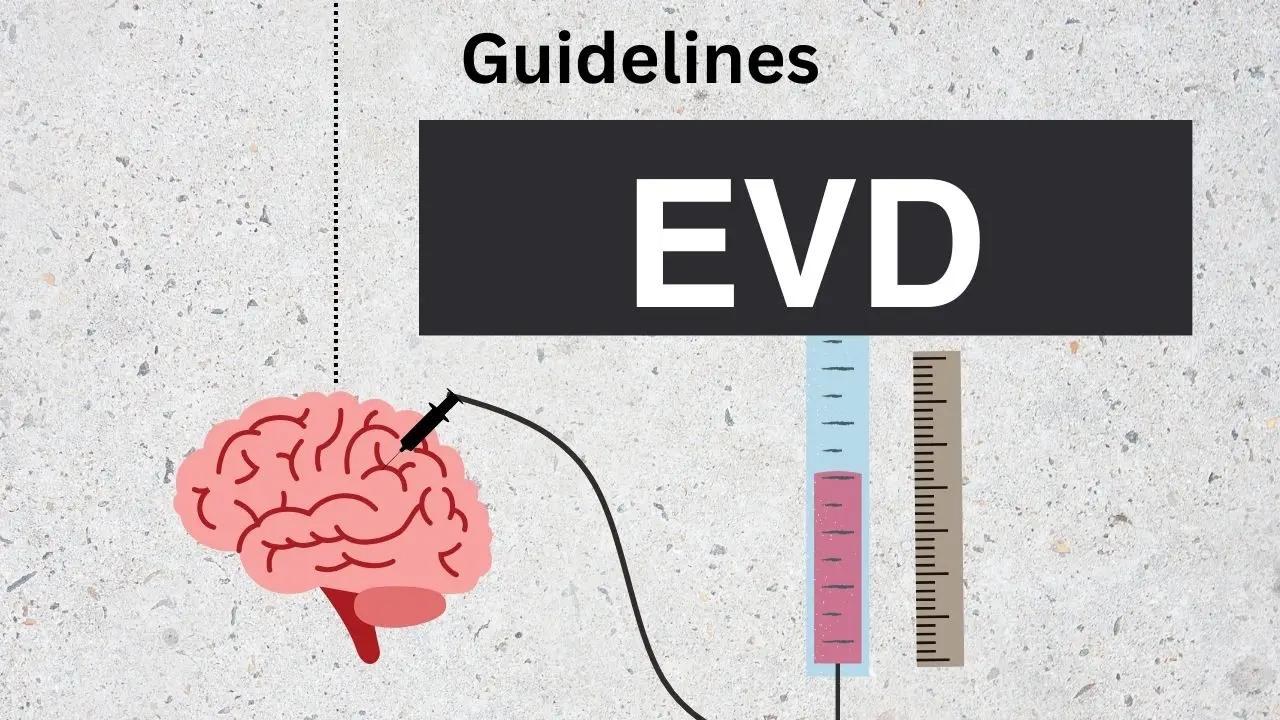Mobilizing patients with extraventricular drains (EVDs) can be dangerous if certain parameters are not followed.
These guidelines should help you know how to better manage EVDs when mobilizing patients for physical and occupational therapy.
What’s an EVD?
An External Ventricular Drain or EVD is a device used for monitoring intracranial pressure (ICP).
The device is usually hanging from an IV pole with a catheter inserted into the ventricles of the brain. This allows for excess CSF fluid to be drained and monitored to reduce hydrocephalus.
Why do we monitor ICPs?
Brain swelling cannot be physically displaced since it is encased in the skull therefore an increase in pressure in the skull occurs. This increased pressure can cause contents of the brain to shift to the un-swollen side, distorting nerve pathways or worst case leading to brain herniation and death. If the ICP level approaches the mean arterial blood pressure, an impairment of cerebral blood flow will occur. (CPP= MAP -ICP). Sustained ICP
>20mmHg is a strong predictor of poor outcomes. Thus, monitoring and management to keep ICP below 20mmHg through use of an EVD is the goal. Sustained elevation in ICP may be an indication for neurosurgical intervention.
What is an EVD?
An external ventricular drain or ventriculostomy drains blood and CS causing a decrease in intracranial pressure. It is an open system which manages ICP by allowing drainage to occur directly from the brain to the device unless clamped off. Some systems also measure ICP or a separate ICP device is also attached.
When is an EVD used?
An EVD is used to measure ICPs and to drain blood or CS that the ventricular system of the brain has difficulty draining itself. It may be due to excess fluid buildup or difficulty of the ventricles to drain caused by an injury to the brain (i.e. subdural hematomas, TBIs are associated with hydrocephalus, brain swelling from meningitis, hemorrhage from stroke).
Are EVDs used long term?
No. EVDs are a short-term solution to manage increased ICPs or hydrocephalus, and if the underlying hydrocephalus or cause for increased ICs does not eventually resolve, it may be necessary to convert the EVD to a VP shunt.
What are the normal parameters for adult ICPs and CPPs?
Normal CPP = >60, Normal ICP = 0-20.
Having a CP < 50 mmHg indicates likely there is an inadequate level of cerebral blood flow.
How is CPP and ICP related to BP?
Cerebral Perfusion Pressure (CPP) = Mean Arterial Pressure (MAP) – Intracranial Pressure (ICP).
This represents the pressure gradient driving cerebral blood flow for oxygen delivery. The MAP is derived from a person’s blood pressure. If the MAP is low, it represents poor perfusion to the brain.
An elevated blood pressure, or “permissive hypertension in stroke patients, or MAP goal is usually set for increased perfusion to the brain. Alternatively, strict MAP goals may be present to prevent further hemorrhaging to the brain.
MAP goals are also important in septic patients, or critically ill patients that are on vasopressor agents. Nurses might tell you that a MAP number shoulder be >60 at all times if patient is on vasopressors. (See ICU cheat sheet).
Where is the EVD catheter typically inserted in the brain?
Typically the lateral ventricle.
Treatment guidelines for patients with EVD
Before a patient is mobilized in anyway, the EVD must be clamped. The level of the transducer should not change while the EVD is open!
The elevation of the HOB must not change, height of bed must not change, and patient position in the bed should not change while the drain is open! (This is a nursing function and requires RN to be present at the bedside during therapy sessions).
What could happen if a patient is mobilized while the EVD is not clamped?
If the patient position or the drain position were changed while the drain is open, this would immediately affect the degree of drainage of the CSF and therefore ICPs.
- For example, if the drain fell on the ground, the ventricles would have NO resistance to drainage, and excessive CSF would collect into the drain, causing a shriveling of the ventricles and a significant and dangerous drop in ICP.
- Versus, if the drain was lifted above the patient’s head, then the ventricles would not be able to fight the pressure gradient, and CSF would not be able to drain at all, therefore causing excessive collection of CS and excessively high ICs, causing a risk for brain herniation.
- Always make sure the EVD is clamped before mobilizing the patient.
Can PT or OT Clamp the EVD?
No! The nurse must be called in to clamp the EVD for us prior to mobilization. Because generally clamping times are brief, it is recommended to setup the environment first, then ask the nurse to come in and clamp to optimize time with the patient.
Mobilizing patients with an EVD
When mobilizing patients with an EVD make sure it is clamped and does not get pulled out.
Monitor for any mental status changes (i.e. mood, cognition, motor) while working with a patient while the EVD is clamped.
Why is it important to make note of an acute change in mental status?
It may be a sign that the patient is not responding well to lack of continuous drainage via EVD due to CS buildup. Alert the nurse if there are mental status changes.
Who do you obtain orders from for activity level and clamping orders for EVD?
Neurosurgery will place an order if it is appropriate. An order should be put into Cerner and should include the duration of time that the EVD can be clamped.
- The drain pressure is determined by the neurosurgeon, and is usually set in the OR, to determine how aggressive the drainage should be.
What values are important to document in your PT and OT notes
Document the ICPs at the start of a session before mobilizing a patient, and at the end of the session.
Normal Parameters are listed below.
| Normal Parameters | |
| Normal ICP | 0-20mmHg |
| Normal CPP | >60 mmHg |
| MAP | >60 mmHg |
| Ok to work with a patient who has an EVD when the ICPs are: | As per MD order |
Conclusion
In summary, navigating EVD patients in the ICU involves understanding the intricacies of ICP, EVD usage, and collaboration with the healthcare team.
Proper management and documentation are essential for optimal patient care, ensuring adherence to treatment guidelines and maximizing safety during your therapeutic interventions.

David is the lead editor of OT Focus. He has been practicing as an Occupational Therapist since 2013. He specializes in acute care, hand therapy, and ergonomics.




